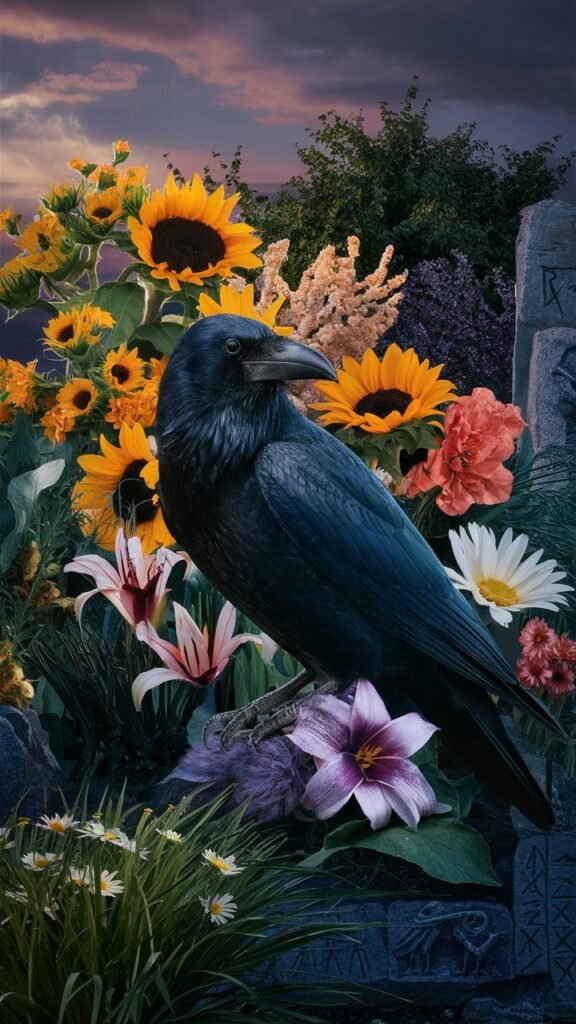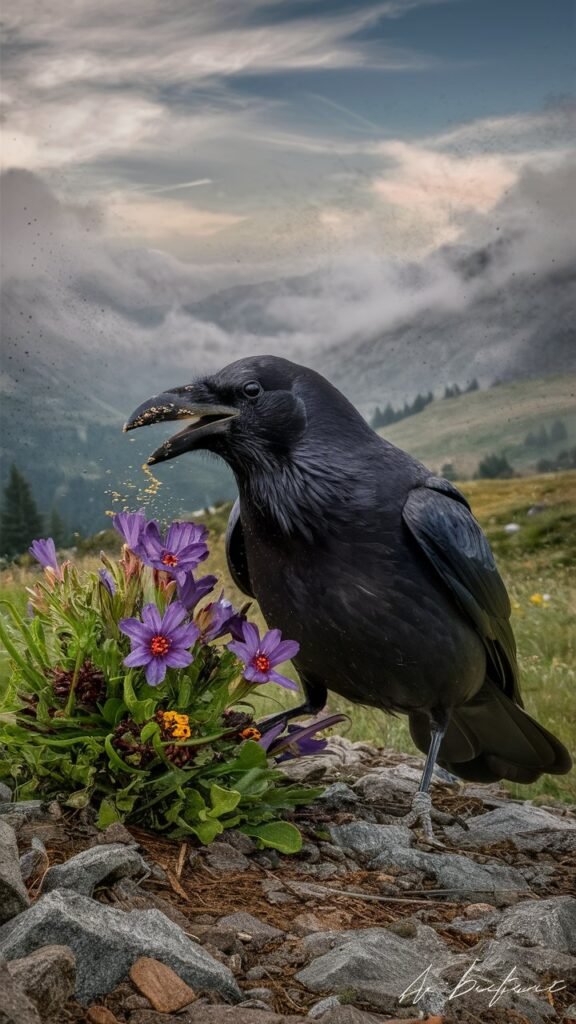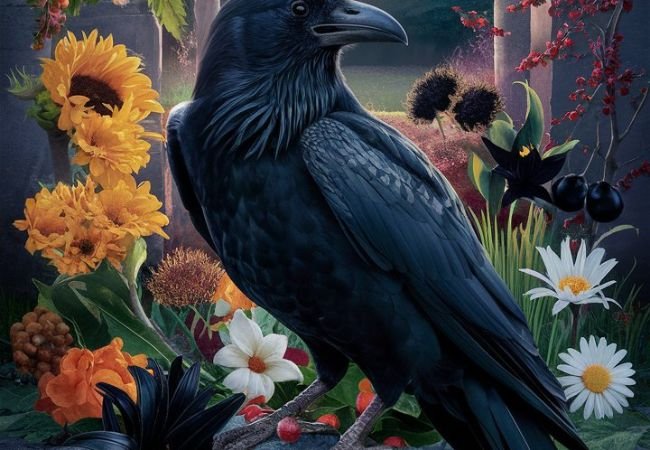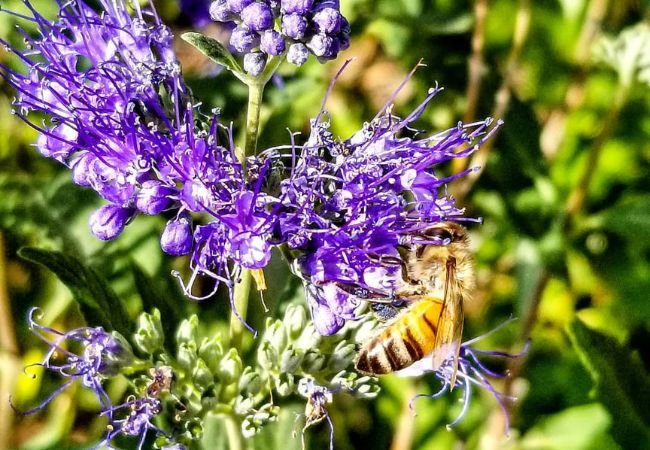Discover how Ravens and flowers unique combination can inspire your gardening, deepen your appreciation of nature and connect you to ancient cultural wisdom.
Ravens and flowers may seem like an unlikely pairing, but these two elements of nature share a rich tapestry of connections in mythology, ecology and garden design. From the role of ravens in pollination to flowers named after these intelligent birds, this exploration will unveil the surprising links between corvids and flora.
As a naturalist and cultural ecologist with over two decades of experience studying the interactions between wildlife and plants, I’m excited to share insights into the intriguing world where ravens meet flowers. Let’s embark on a journey that bridges the gap between sky and soil!
The Raven: More Than Just a Black Bird

Before we dive into the connections with flowers, let’s briefly explore what makes ravens so special:
- Ravens (Corvus corax) are among the most intelligent birds, known for problem-solving abilities and tool use.
- They play significant roles in many cultures’ mythologies and folklore.
- Ravens are adaptable and found in diverse habitats across the Northern Hemisphere.
- They have complex social behaviors and vocalizations.
Now, let’s explore how these fascinating birds intersect with the world of flowers.
Ravens and Pollination: Unexpected Floral Allies
While not typically considered pollinators, ravens can play a role in plant reproduction:
Indirect Pollination: Ravens may inadvertently transfer pollen as they move from flower to flower in search of insects or nectar-drinking birds to prey upon.
Seed Dispersal: Ravens contribute to plant distribution by carrying seeds in their beaks or digestive tracts, potentially over long distances.
2024 Research Update: Recent studies are exploring the potential impact of climate change on raven foraging patterns and their subsequent effects on alpine and subalpine plant communities.
Flowers Named After Ravens
Several plants have been named after ravens, often due to their dark coloration or cultural associations:
1. Ravenswing (Anthriscus sylvestris ‘Ravenswing’)

A cultivar of wild chervil with striking dark purple-black foliage.
2024 Gardening Trend: Increasing popularity in modern gothic garden designs.
Growing Tip: Plant in partial shade for best foliage color.
2. Raven Grass (Liriope spicata ‘Silver Dragon’)
While not truly black, this grass-like plant is sometimes called raven grass due to its dark green leaves with silver striping.
2024 Landscape Design Insight: Growing use in minimalist, monochromatic garden schemes.
Planting Tip: Use as a low-maintenance ground cover in shady areas.
3. Black Lily (Fritillaria camschatcensis)
Also known as the raven’s bell, this lily produces dark purple-black flowers.
2024 Conservation Focus: Efforts to protect wild populations in their native Asian habitats are increasing.
Cultivation Note: Requires cool, moist conditions to thrive.
Raven-Inspired Garden Designs
The mystique of ravens can inspire unique garden themes:
1. The Raven’s Realm Garden
Create a moody, atmospheric garden using plants with dark foliage and flowers:
- Black Mondo Grass (Ophiopogon planiscapus ‘Nigrescens’)
- Black Hollyhock (Alcea rosea ‘Nigra’)
- Dark purple or near-black varieties of Iris and Tulips
2024 Design Trend: Incorporating augmented reality experiences in gardens, allowing visitors to see digital ravens interacting with physical plants.
2. The Trickster’s Garden
Inspired by the raven’s reputation as a clever trickster in many mythologies:
- Plants with unusual features like the Venus Flytrap (Dionaea muscipula)
- Optical illusion garden layouts
- Interactive plant species that move or change with touch
2024 Innovation: Development of smart gardens that use AI to create dynamic, ever-changing landscapes inspired by raven behavior.
3. The Raven’s Feast Garden
Focus on plants that attract ravens and other corvids:
- Sunflowers (Helianthus annuus)
- Elderberry (Sambucus nigra)
- Wild cherry trees (Prunus avium)
2024 Ecological Trend: Growing interest in creating backyard habitats that support urban wildlife, including corvids.
Ravens in Floral Mythology and Symbolism
Ravens and flowers intersect in various cultural myths and symbolic systems:
Norse Mythology
Odin’s ravens, Huginn and Muninn, are sometimes associated with the Yggdrasil, the world tree, which is often depicted with flowers and fruits.
Native American Traditions
In some Pacific Northwest cultures, the raven is a creator figure responsible for bringing plants and flowers to the world.
Victorian Flower Language
While not directly related to ravens, the language of flowers (floriography) often used dark flowers to symbolize mystery or sorrow, qualities also associated with ravens.
2024 Cultural Resurgence: Renewed interest in traditional plant lore and symbolism, with modern interpretations incorporating raven themes.
Observing Ravens in Your Flower Garden
For those interested in attracting ravens to their garden:
- Plant native fruit-bearing shrubs and trees.
- Create diverse habitats with a mix of open areas and dense plantings.
- Provide a water source like a birdbath or small pond.
- Consider adding a platform feeder with a variety of foods.
2024 Citizen Science Opportunity: Participate in urban corvid behavior studies through new mobile apps that allow you to record raven-plant interactions in your garden.
Ethical Considerations
When incorporating raven themes or attempting to attract these birds:
- Use native plants whenever possible to support local ecosystems.
- Avoid harmful pesticides that could affect ravens and other wildlife.
- Respect local wildlife regulations regarding feeding and interaction with wild animals.
- Consider the impact on neighbors and local ecosystems before significantly altering your garden.
Conclusion: Bridging Sky and Soil
The connection between ravens and flowers offers a unique lens through which to view the natural world. By exploring this relationship, we gain a deeper appreciation for the complex web of life that surrounds us. Whether you’re inspired to create a raven-themed garden, observe corvid behavior among your blooms, or simply ponder the cultural significance of these birds and plants, the raven-flower connection provides a rich tapestry of possibilities.
Remember, gardening and nature observation are ongoing journeys of discovery. Stay curious, keep learning, and don’t be afraid to think outside the box – or outside the flower bed!
For more information on ravens, native plants, and wildlife gardening, visit resources like the Audubon Society or your local botanical garden. Happy gardening and may your outdoor spaces be filled with the beauty of flowers and the fascinating presence of ravens!
For more gardening tips and plant care guides, visit usagardenhub.com.






One comment on “Ravens and Flowers : A Fascinating Natural and Cultural Connection (2024 Exploration)”